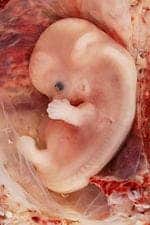A number of human-like unique limb features, like the thumb, can be witnessed from the earliest most stages of development. Intuition tells us that this means the genetic changes and material that underlie these traits are active in the embryo stage. Recently, researchers Yale School of Medicine found there are thousands of active sequences that control gene activity in the developing human limb. These are believed to have played a major part in the evolution of the highly dexterous, and in many aspects unique, human arms and legs.

Its important to note that the exact genetic mechanisms that control development of human limbs have not been identified, but instead provides scientists with the first genome-wide view of candidates to investigate.
“We now have a parts list that may account for these biological changes,” said James P. Noonan, associate professor of genetics, investigator for the Kavli Institute and senior author of the study.
In order to trace where these gene sequences might be, the researchers compared the human genome against other genomes. Previous research starting with 2008 used this approach to identify a single human gene regulatory sequence showing human-specific activity in the developing limb that may have contributed to the evolution of the human thumb, after the human genome was put against the genome of other primates. Results back then weren’t enough to explain just how many of these active sequences were involved.
The present paper looked for differences in the activity of these regulatory sequences across the entire genomes of human, rhesus monkey, and mouse during limb development. These active regulatory sequences were identified and tagged using a specific biomarker, before being mapped. Subsequent analysis of these maps showed that all three species go through more or less the same limb development genetics, before branching out . Specifically, the researchers found a fraction of regulatory sequences are active only in the human embryonic limb. These sequences likely gained activity since humans’ divergence from the rhesus monkey about 25 million years ago.
“It has been difficult to understand how human traits evolved, because we didn’t have any idea where the important genetic changes might be,” Noonan said. “Now we do, and we have the experimental tools to determine what biological effects these changes may have. Our study also provides a roadmap for understanding other human-specific traits that arise during development, such as increased brain size and complexity.”
The paper was published in the journal Cell on July 3.






